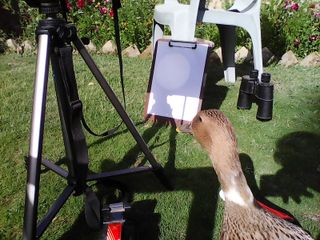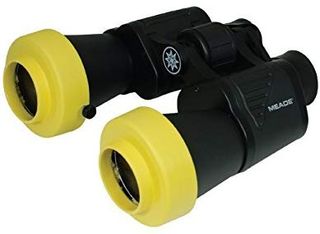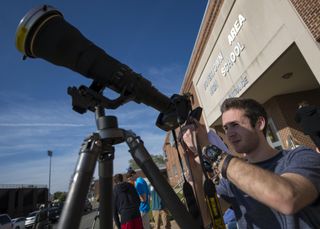Mercury will pass across the face of the sun Monday (Nov. 11) in its first such "transit" since 2016.
The Mercury transit — which begins Monday at 7:35 a.m. EST (1235 GMT) and ends at 1:02 p.m. EST (1804 GMT) — is accessible to amateur astronomers, as long as they have the right equipment to view the event safely. (Warning: Never look directly at the sun without protection; serious and permanent eye damage can result.)
Here's a brief rundown of the ways you can safely watch the transit, either first-hand or live online.
Projecting the image
Mercury is so small that projecting the image using a simple pinhole camera, as many observers do to view
solar eclipses, will not produce good results; it's likely you won't be able to see anything at all. Instead, you can project the image using
binoculars, refractors or small Newtonian telescopes. (Schmidt-Cassegrain and Maksutov designs can't be used for this, because of the risk of damage.)
Put a low-power eyepiece into your
telescope — one that you don't mind losing if the sun's heat cracks it. Do not look through the eyepiece or the finder scope. Instead, align the telescope using its shadow on the ground. The more closely aligned the scope is to the sun, the darker and more circular its shadow will appear, according to the British Astronomical Association (BAA).
Take a piece of white paper and hold it about 1 foot (30 centimeters) away from the eyepiece to see the image. You may need to wiggle the telescope a bit to get a good view.

Physics lecturer Mohammad Baqir and his pet duck observed the May 9, 2016 Mercury transit using safe projection techniques.
Binoculars or telescopes
You can also
outfit your binoculars or telescope with solar filters to view the transit. The type of solar filter depends on your equipment, so check with the manufacturer to see what's approved.
Alternatively, you can make your own filters using a sheet of Mylar or
Baader AstroSolar Film. Just be sure that the homemade filter is securely over the front end of your binoculars or telescope, with no cracks.
"It is essential that the filter fixes very securely to your telescope, that it is undamaged, and that it is designed for safe use with your telescope," the BAA officials
wrote in a press release. "Only buy from reputable suppliers you trust, and thoroughly inspect your filters for damage every time you use them."
Filters designed for eyepieces should never be used because they are "of suspect quality" and often crack when exposed to the sun's heat, the BAA added.

This
"EclipSmart" telescope from Celestron has a built-in solar filter that is ISO-certified and comes with accessories and a carrying case. The telescope provides 18x magnification.

A student uses his smartphone and a photographers lens with a solar filter to capture a photo of the planet Mercury transiting the sun on May 9, 2016.
Community telescopes
Many museums or amateur astronomy organizations are holding special public events for the Mercury transit. So if you don't have your own gear, check the nearest science museum or astronomy club to see if they are going to set something up somewhere in your community.
Watching online
Another option is to watch the transit from wherever you happen to be that day, which is especially handy if you are stuck at work or school. Space.com will show live webcasts from Slooh and the Virtual Telescope Project.
The Slooh online observatory will begin streaming live views of the Mercury transit from telescopes around the world at 7:30 a.m. EST (1230 GMT). You can
watch it live here on Space.com or directly via
Slooh's YouTube channel.
At the same time, astrophysicist Gianluca Masi of the Virtual Telescope Project in Italy will also stream live telescope views of the transit. You can watch the free webcast live
here.
Meanwhile, NASA will post real-time images from its Solar Dynamics Observatory at
mercurytransit.gsfc.nasa.gov/2019.
Editor's note: Visit Space.com on Monday
to see live webcast views of the rare Mercury transit from Earth and space, and for complete coverage of the celestial event. If you SAFELY capture a photo of the transit of Mercury and would like to share it with Space.com and our news partners for a story or gallery, you can send images and comments in to managing editor Tariq Malik at
spacephotos@space.com.
 Physics lecturer Mohammad Baqir and his pet duck observed the May 9, 2016 Mercury transit using safe projection techniques.
Physics lecturer Mohammad Baqir and his pet duck observed the May 9, 2016 Mercury transit using safe projection techniques.





Comments
Post a Comment